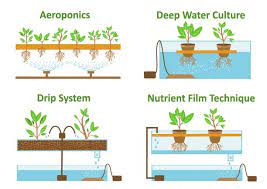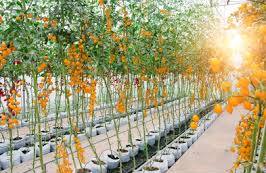HYDROPONICS-TECHNIQUES, WORK PROCESS & ADVANTAGE
INTRODUCTION
Plants need sunlight, water, nutrients, and chlorophyll inside their leaves to convert carbon-dioxide and water into glucose and oxygen, for what we call photosynthesis. The equation is represented by formula-
6CO2 + 6H2O → C6H12O6+ 6O2
We can clearly see that there is no need of soil here; it means plant can grow without soil. What they need are water and nutrients which is obtained from soil. If these are provided through other means like by standing with their roots in a nutrient-rich solution, they can grow.
SO WHAT IS HYDROPONICS?
Growing plants without soil is known as hydroponics. It is the process of growing crop directly in nutrient rich solution or say by standing with their roots in nutrient-rich water without soil. That’s the basic idea behind hydroponics.
The nutrients used in hydroponic systems have many different sources, like fish excrement, duck manure, purchased chemical fertilizers, or artificial nutrient solutions.
Plants commonly grown using this technique include tomatoes, peppers, cucumbers, strawberries, lettuces, cannabis, and also some model plants like Arabidopsis thaliana.
WHAT ARE REQUIREMENTS IN HYDROPONICS?
- Fresh water– Most plants like water with a pH level around 6–6.5
- Oxygen– Depending on hydroponic setup, it is necessary to leave space between the base of your plant and the water reservoir otherwise need to oxygenate the container.
- Light- while growing plants indoor, lighting should be according to need of plants type.
- Root support– Usually, materials like vermiculite, perlite, peat moss, coconut fiber, and rock wool are used to support root system.
- Nutrients- Nutrients solution must include all foods to feed the plants essential for growth and development.Read… ROLE OF ESSENTIAL PLANT NUTRIENTS
ESSENTIAL NUTRIENTS-DEFICIENCY SYMPTOMS
TECHNIQUES
- Static Solution Culture– plants are generally grown in containers filled with nutrient solution, such as glass, jars, pots, buckets, tubs, or tanks. A hole is cut in the top of the reservoir for each plant; if it a jar or tub, it may be its lid, but otherwise, cardboard, foil, paper, wood or metal may be put on top. Reservoir size can be adjusted based on plant size. The nutrient solution is changed either on a schedule, such as once per week, or when the concentration drops below a certain level as determined with an electrical conductivity meter. Whenever the solution is depleted below a certain level, either water or fresh nutrient solution is added.
- Aeroponics– It is a system wherein roots are kept in an environment saturated with fine drops of nutrient solution. The method requires no substrate and entails growing plants with their roots suspended in a deep air or growth chamber with the roots periodically wetted with a fine mist of atomized nutrients. Excellent aeration is the main advantage of aeroponics. The suspended aeroponic plants receive 100% of the available oxygen and carbon dioxide to the roots zone, stems, and leaves, thus accelerates biomass growth and reduces rooting times. This technique has also proven to be commercially successful for propagation, seed germination, seed potato production, tomato production, leaf crops, and micro-greens. Aeroponics is often used in laboratory studies of plant physiology and plant pathology. Aeroponic techniques have been given special attention from NASA since a mist is easier to handle than a liquid in a zero-gravity environment.

Hydroponics Illustration - Continuous flow solution culture/Nutrient film technique– In this technique, the nutrient solution constantly flows past the roots. It is much easier to automate than the static solution culture because sampling and adjustments to the temperature, pH, and nutrient concentrations can be made in a large storage tank that has potential to serve thousands of plants. The nutrient film technique (NFT) is a popular variation whereby, a very shallow stream of water containing all the dissolved nutrients required for plant growth is recirculated past the bare roots of plants in a watertight thick root mat, which develops in the bottom of the channel. Here sufficient supply of oxygen is provided to the roots of the plants. A nutrient film system works best with fast-growing, shallow-rooted plants such as lettuce, spinach, radishes, and herbs. The NFT system is based on using the right channel slope, the right channel length and the right flow rate. The main advantage of this system over other forms of hydroponics is that the plant roots are exposed to adequate supplies of water, oxygen, and nutrients. As a result, higher yields of high-quality produce are obtained over an extended period of cropping.
- Flood and Drain system– This technique is also called ebb and flow system. It is somewhat more complex in design but is extremely versatile. This system works by flooding the growing medium with a water-nutrient solution, then it drains back into the reservoir. This keeps the medium regularly flushed with nutrients and air.

Grape Hydroponics
ADVANTAGES OF HYDROPONICS
Despite some limitation, Hydroponics offers many advantages which are briefly summarized below.
- Water usage– This technique decrease water usage in agriculture. At vertical roots, our systems use up to 98 percent less water than traditional soil-based systems. For example, to grow 1 kilogram of tomatoes using intensive farming methods requires 400 liters of water; while using hydroponics, only 70 liters are required.
- Resources– It allows growers to produce food anywhere in the world, at any time of the year, and to net higher yields with fewer resources than conventional method of farming.
- Risk mitigation & more yield– it reduces the risk of crop loss from inclement weather. Plants get their required nutrients and water can mature up to 25 percent more quickly than the same plants grown in soil. Because hydroponically grown plants dip their roots directly into nutrient-rich solutions, they get what they need much more easily than plants growing in soil, so they need much smaller root systems and can divert more energy into leaf and stem growth. Ultimately more yields are obtained.
- Usage of Pesticides and other potentially harmful chemicals– The hydro crops are protected from many of the pests and plant diseases found outdoors in soil-based farms. It doesn’t require harmful chemicals applied to soil-borne diseases.